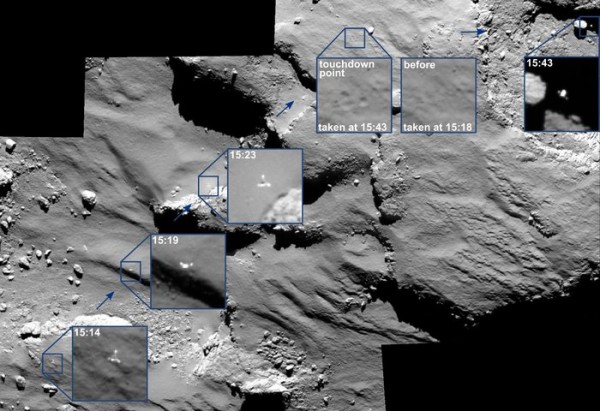Hear How the First Comet Landing Sounds Like
| Ana Verayo | | Nov 20, 2014 08:28 PM EST |
(Photo : ESA/Rosetta/MPS for OSIRIS Team MPS/UPD/LAM/IAA/SSO/INTA/UPM/DASP/IDA) These incredible images show the breathtaking journey of Rosetta’s Philae lander as it approached and then rebounded after its first touchdown on Comet 67P/Churyumov–Gerasimenko on 12 November 2014.
Now, anyone can hear the historical comet landing of Philae, the robotic probe that's now on the surface of Comet 67P 67P/Churyumov-Gerasimenko.
Listen to the soft landing of the Philae lander here: https://soundcloud.com/dlrde/touchdown-philae-on-comet-67p
Like Us on Facebook
The crunching sound from the thud is apparently the sound Philae made when it came into contact with Comet 67P's surface. Philae is the first spacecraft in history to land on a comet.
The lander's Cometary Acoustic Surface Sounding Experiment (CASSE) instrument recorded a more audible, distinct sound from the soft landing. Philae bounced twice off the surface and settled in the deep shadow of a cliff.
Since sound can't be recorded in the vacuum of space, the sound Philae made emanated from the interior of Philae and not the exterior. The interior of the small space lab is tightly sealed and its instrument chambers are pressurized so molecules can vibrate and produce sound waves.
CASSE's primary mission is to take measurements of Philae's landing legs when they hit the surface and gather data about the comet's surface, said Klaus Seidensticker of the Deutsches Zentrum für Luft-und Raumfahrt (DLR) who monitors the Surface Electric Sounding and Acoustic Monitoring Experiment (SESAME).
Philae landed on a soft layer about seven centimeters thick. The lander's feet encountered the hard, ice-like layer of the comet beneath this layer after a few milliseconds.
This short recording is evidence Philae's intended landing didn't go as planned since there isn't any sound after the first contact.
Martin Knapmeyer, leader of the CASSE Team, said the data determined the second landing didn't occur immediately after the first bounce.
The European Space Agency and the Philae team concluded the lander was gliding near the comet's surface for nearly two hours when audio sensors were silent. The lander bounced once on landing and came to a final halt 3,300 feet from the landing site named Agilkia.
Since its landing, Philae has been trying to conserve energy and acquire solar power to continue its mission.
TagsHear How the First Comet Landing Sounds Like, ESA, rosetta, philae, comet landing, comet 67P, sound of comet landing, hear first comet landing sound
©2015 Chinatopix All rights reserved. Do not reproduce without permission
EDITOR'S PICKS
-

Did the Trump administration just announce plans for a trade war with ‘hostile’ China and Russia?
-

US Senate passes Taiwan travel bill slammed by China
-

As Yan Sihong’s family grieves, here are other Chinese students who went missing abroad. Some have never been found
-

Beijing blasts Western critics who ‘smear China’ with the term sharp power
-

China Envoy Seeks to Defuse Tensions With U.S. as a Trade War Brews
-

Singapore's Deputy PM Provides Bitcoin Vote of Confidence Amid China's Blanket Bans
-

China warns investors over risks in overseas virtual currency trading
-

Chinese government most trustworthy: survey
-

Kashima Antlers On Course For Back-To-Back Titles
MOST POPULAR
LATEST NEWS
Zhou Yongkang: China's Former Security Chief Sentenced to Life in Prison

China's former Chief of the Ministry of Public Security, Zhou Yongkang, has been given a life sentence after he was found guilty of abusing his office, bribery and deliberately ... Full Article
TRENDING STORY

China Pork Prices Expected to Stabilize As The Supplies Recover

Elephone P9000 Smartphone is now on Sale on Amazon India

There's a Big Chance Cliffhangers Won't Still Be Resolved When Grey's Anatomy Season 13 Returns

Supreme Court Ruled on Samsung vs Apple Dispute for Patent Infringement

Microsoft Surface Pro 5 Rumors and Release Date: What is the Latest?










